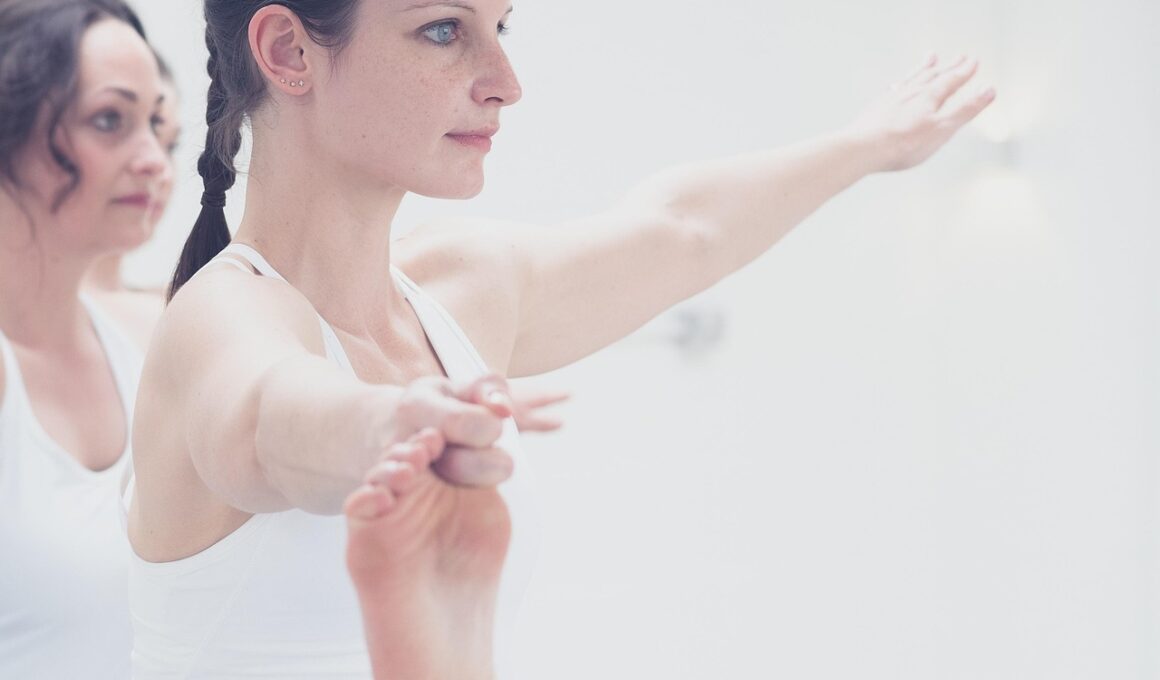Stretching and Flexibility for Core Health
Core health significantly benefits from regular stretching and flexibility exercises. Proper core training not only involves strengthening the abdominals, obliques, and lower back muscles but also improving flexibility. Flexibility enhances your range of motion, reduces the risk of injuries, and aids in recovery. Stretching can be categorized into dynamic and static forms. Dynamic stretching is best before workouts, promoting blood flow and warming up the muscles. On the other hand, static stretching helps cool down your muscles post-exercise. Incorporating both types into your routine is crucial for optimal core development. A balanced core training program enhances posture, athletic performance, and everyday functional movements. Your core stabilizes your body during movements ranging from walking to lifting heavy objects. Remember to breathe deeply while stretching to maximize your performance. Studies show that improved flexibility directly correlates with a decreased incidence of injuries among fitness enthusiasts and athletes. Hence, prioritize stretch sessions within your workout regimen. Additionally, consider incorporating yoga or Pilates, both of which emphasize core strength and flexibility, as valuable supplements to your routine. They can provide balanced benefits not only to your core but overall body wellness.
The Importance of Stretching
Stretching is essential in maintaining optimal core health and muscle performance. It increases blood flow to the muscles, which enhances nutrient delivery and accelerates recovery. Lack of flexibility can lead to muscle imbalances, making muscles tight and overworked. This imbalance can result in discomfort, stiffness, and pain, particularly in the lower back area. Furthermore, regular stretching can alleviate muscle tightness. Stretching the major muscle groups in the core helps them to function better together. Increased flexibility across the core can improve balance and stability. For those engaged in sports, improved flexibility means superior performance, reducing fatigue and enhancing endurance levels during activities. Start with easy stretches targeting the abdominal and back muscles. Incorporate stretches like the cat-cow stretch and cobra pose for effective outcomes. As you grow more accustomed to your stretching routine, include variations that progressively increase your flexibility. This practice can significantly boost your overall effectiveness in workouts or daily activities. Always listen to your body while stretching. If an exercise causes pain, stop immediately to prevent injury. Seek guidance from fitness professionals for personalized stretching exercises.
Core stretching exercises can be categorized into several types, each with its unique benefits. One popular form is stability ball stretching. By using a stability ball, you can target multiple muscle groups simultaneously, enhancing both balance and flexibility. Another effective option is dynamic stretches, which involve movement while stretching. These can include torso twists and leg swings. Both methods emphasize core muscles while promoting flexibility. Additionally, consider incorporating foam rolling into your routine. Foam rollers can help release tightness in the muscles and fascia, improving flexibility. Another highly recommended practice is yoga. Yoga not only improves flexibility but integrates breathing techniques that enhance overall well-being. If you’re unfamiliar with various stretching techniques, consider consulting online fitness resources or join a class in your local gym for expert guidance. Share your fitness goals with a trainer who can tailor a flexible stretching regimen to align with your core training. It is crucial to set time aside specifically for stretching to ensure you reap benefits as part of an effective core routine. Ultimately, longevity in fitness hinges on caring for your muscles through flexibility training, creating lasting benefits for higher functionality.
Combining Stretching with Strength
For comprehensive core training, blending strength exercises with proper stretching is vital. It complements the benefits of both modalities seamlessly. Strengthening your core provides the foundation necessary for grander physical activities. Weight-bearing exercises like planks or deadlifts emphasize required abdominal muscles. Yet after intensely working these muscles, ensure you dedicate adequate time for stretching. This combination prevents post-exercise tightness, which can hinder performance and recovery. Furthermore, it allows the muscles to remain pliable, facilitating greater strength gains. Start your workouts with a dynamic stretching routine to warm up the core, followed by a solid strength training workout. Finally, finish off with static stretching to allow muscles time to recover adequately. Additionally, periodization in your training program could involve alternating heavy and lighter days with equal importance to stretching considerations of core muscles. Wondering how often you should integrate stretching? The answer is, as often as necessary! Ideally, stretch post-workout at least 2-3 times a week to maximize flexibility results. Regular practice can lead to monumental improvements, subsequently leading to overall enhanced athleticism and quality of life.
Common misconceptions about stretching often lead to underutilization in core training programs. Previously, myths suggested that stretching could weaken muscles temporarily before workouts. This notion has been debunked through various studies proving that proper stretching enhances, rather than impedes, strength and skill. When performed at appropriate durations, stretching serves as a vital precursor to any workout regime. Consult various research reports to find reputable sources that clarify the myths surrounding stretching. Many successful athletes endorse stretching as instrumental in their training routines. Flexibility training has remarkable cumulative benefits that positively influence performance, minimizing injury risk. Moreover, the integration of efficiency-focused stretching techniques can considerably affect outcomes. Adopting practices like PNF (Proprioceptive Neuromuscular Facilitation) stretching, partnered with fellow exercise enthusiasts, will improve flexibility levels extraordinarily well. Ultimately, customized stretching protocols can lead to drastic improvements in core performance and may positively affect general body health. Undertake your flexibility journey with professional guidance. Explore community classes that specialize in core health through flexibility. This experience can elevate your performance notably.
Listening to Your Body
The journey of enhancing core flexibility through stretching also requires a certain level of mindfulness. As you advance, your body becomes the best guide for what stretches are most beneficial. Always pay attention to how your muscles feel during and after stretching. If certain movements produce discomfort or strain, it’s essential to adjust or seek alternatives. Never push through pain. Instead, focus on attainable flexibility targets. Keeping a journal can facilitate this process and track improvements over time. Document new stretches you’ve tried, note your comfort levels, and assess improvements regularly. Such a mindful approach not only fosters personal growth but enables you to celebrate small victories on your journey toward enhanced flexibility. Moreover, welcoming personal changes is essential as you evolve both physically and mentally through your training journey. Flexibility may improve gradually but continually committing to both core strengthening and stretching meetings the profound benefits over time. Engage with various communities within fitness circles; share thoughts and experiences on flexibility that could motivate others. Ultimately, intertwining understanding and respect for your body allows for balanced and successful core performance.
Incorporating stretching and flexibility training into your core health routine is vital, but the approach should be well-structured. Establish a routine that dedicates specific days to core training versus flexibility work. A well-planned schedule incorporates both elements together for optimal effectiveness. Consider setting a designated time each week for focused stretching; this should ideally occur after core workouts. Allow at least 15 to 30 minutes dedicated to stretching sessions to achieve desired outcomes. Furthermore, you can divide your stretching routine into shorter intervals throughout the week rather than attempting to do everything in one stretch session. This allows consistent engagement and growth. Additionally, prioritize variety in your stretching exercises to avoid monotony, which could deter progress. Always select your stretches based on current flexibility levels and previous workout intensity. Finally, having a set goal in sight to improve core flexibility will ignite motivation, directing workouts. Consider joining workshops on yoga or pilates focused on flexibility improvement. In conclusion, remember connecting with core flexibility can profoundly enhance other areas of fitness and promote long-term well-being together.
In essence, a robust core and optimal flexibility provide the foundation for numerous physical activities. Targeted stretching is essential for maintaining balance and adaptability in muscles. Engage consistently with your stretching practices and commit to ongoing education regarding methods that harmonize with your workout routines. With persistence and patience, results will emerge across different facets of strength, movement, and muscle endurance. Ultimately, integrating core training with flexibility promoting activities leads to a more resilient body, positioning one for success in exercise and daily life activities. As you explore the integral link between core health and flexibility enhancement, maintain a proactive approach to adapting and refining your techniques. Regular feedback from experienced trainers can further enhance your growth and development. Don’t forget to celebrate progress, regardless of how small; it is part of an ongoing journey. Prioritize nurturing your core through strategic flexibility to avoid eventual injuries or imbalances that could derail training. Always stay informed on advancements in this fitness field to maximize knowledge and apply insights beneficially. Stretch your way to better core health and establish a lifelong commitment to your well-being.


